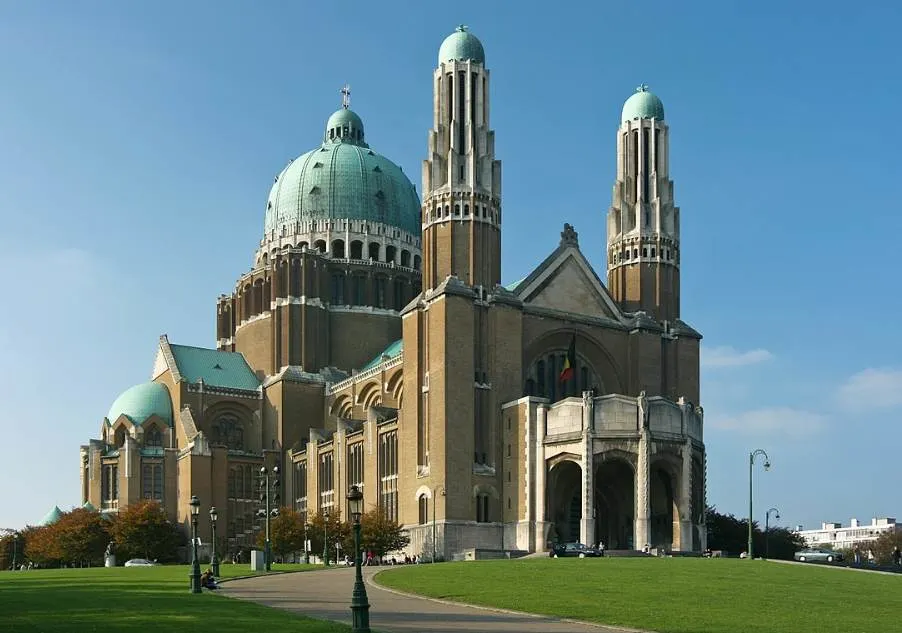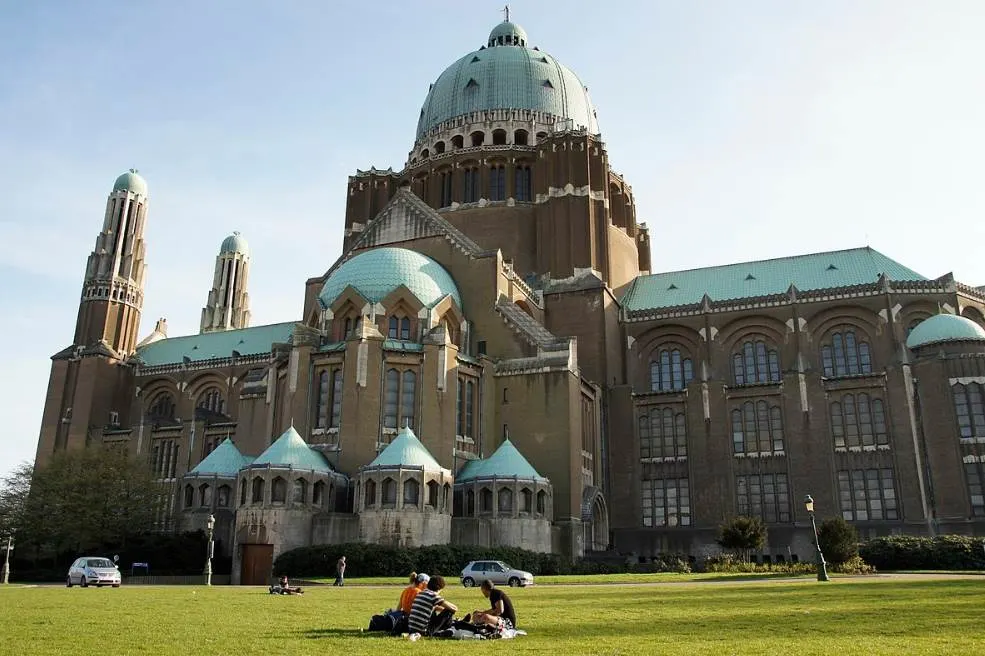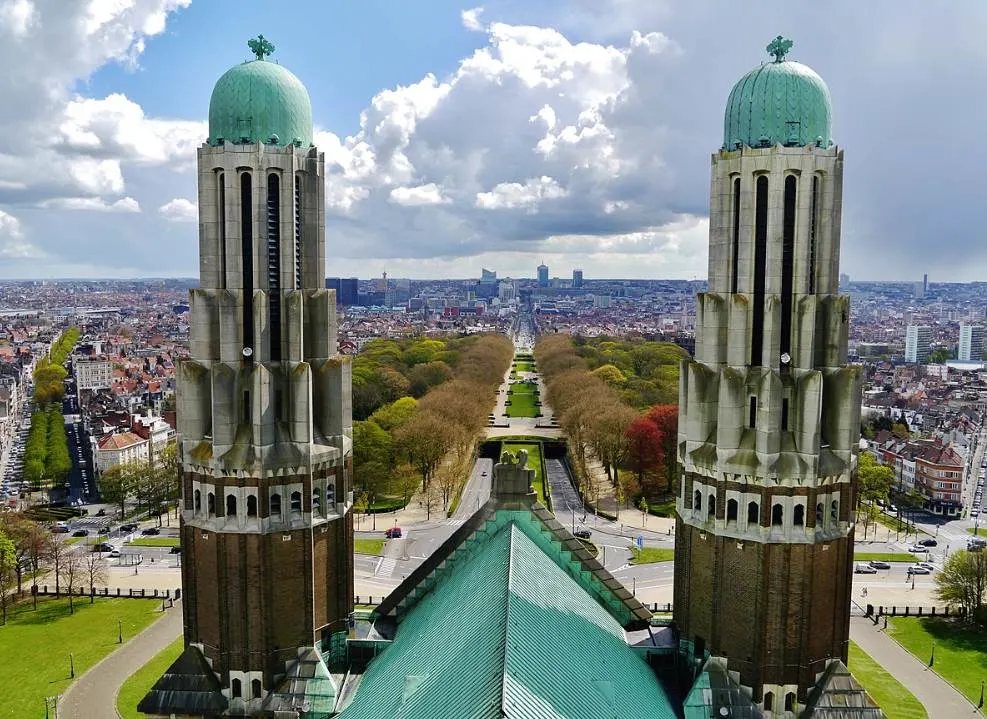The northwestern part of Brussels, the capital city of Belgium, is dominated by an enormous domed structure.
The famous church was constructed on top of a hill which makes it one of the most prominent landmarks in the city.
Let’s take a closer look at some of the most interesting facts about the Basilica of the Sacred Heart, one of the most famous buildings in Brussels.
1. It’s located in a park on the border of 2 municipalities of Brussels
The National Basilica of the Sacred Heart is the official name of a huge church commonly referred to as the Koekelberg Basilica. That’s because it’s located on the border of Koekelberg and Ganshoren, 2 of the 19 municipalities that make up the city of Brussels.
The church is located inside a large green area called the “Parc Elisabeth,” a public park that covers an area of approximately 21 hectares (51 acres).
The church was constructed on top of Koekelberg Hill just northwest of the historical heart of the city. Other famous landmarks in Brussels such as the Atomium and the Castle of Laeken, and the Royal Greenhouses of Laeken, are located just northeast of the basilica.

2. King Leopold II was inspired by a Parisian church in the early 20th century
The project was initiated by King Leopold II (1835-1909), the infamous second King of Belgium between 1865 and 1909. This area of the capital had been vacant since the establishment of Belgium in 1831.
His predecessor King Leopold I (1790-1865) had hopes of turning the area of Koekelberg Hill into one of his private residences but this never happened.
It wasn’t until King Leopold II visited Paris in 1902 that he became inspired to build a church in this area. His main inspiration was the Sacré-Coeur Basilica on top of Montmartre Hill.

Because of this, the basilica was dedicated to the Sacred Heart, just like its inspiration, one of the most famous churches in Paris.

3. The original plan was in a completely different architectural style
The king initially hired a man named Pierre Langerock, an architect from the Belgian city of Leuven. He was mostly known for designing Gothic Revival buildings and designed multiple city halls, trains stations, and even castles all around Belgian in this style.
This makes it no surprise that he also designed the Koekelberg Basilica with pointy spires and windows, the trademark of this medieval architectural style.
King Leopold II laid the foundation of this Gothic Cathedral in 1905 and the foundation was just about completed when World War I broke out in 1914, completely halting construction.

4. The building was only completed 65 years after construction had started
The First World War wasn’t the only tragic event that halted this massive project. World War II and the lack of funds as a result of both wars were two other reasons why the building was only completed in 1970.
The construction of the building was continued in 1919 but another architect was hired, a man named Albert Van Huffel. One of the most interesting facts about the National Basilica of the Sacred Heart in Brussels is that it was completed as an Art Deco Building.
King Albert I was the man who initiated both the resumption of the project and the change in plans. After all, the Gothic plan was deemed way too expensive.

5. It’s one of the biggest churches in the world
The church looks enormous because it’s located on top of a hill. That’s not the only reason, though, because it’s a massive building as well. The structure has the following dimensions;
- Length: 164.5 meters (540 feet)
- Nave length: 141 meters (463 feet)
- Maximum width: 107.8 meters (353.7 feet)
- Nave width: 25 meters (82 feet)
- Height: 89 meters (292 feet)
The dome of the church has a diameter of 33 meters (108 feet) and dominates the skyline of the city. The church has a capacity of 3,500 people and is one of the top 20 biggest churches in the world.

More interesting facts about the Basilica of the Sacred Heart in Brussels
6. The Sacré-Coeur in Paris wasn’t the only famous building in Paris that inspired King Leopold II. He initially had quite a different plan. Following the death of his father, the king had a plan to build a structure similar to the Panthéon in Paris.
This is a famous mausoleum that is reserved for important people in French history. The idea to build a final resting place for “Great Belgians” wasn’t appreciated by the general public and was eventually shelved.
7. The church was consecrated on October 14, 1935, by Cardinal Jozef-Ernest van Roey who acquired permission to do so from Pope Pius XI. The building was far from finished a the time.

8. The original Gothic Revival design for the church was based on designs made by French architect Eugène Viollet-le-Duc (114-1879). He was in charge of numerous renovations projects in France during the 19th century.
Some of his most notable works were the renovation of Sainte Chapelle and Notre Dame in Paris. He conceptualized the idea of the “ideal cathedral” and the Koekelberg Basilica nearly looked as such.

9. The completion of the cathedral was celebrated on November 11, 1970. This also marked the 25th anniversary of the Metropolitan Archdiocese of Mechelen–Brussels to which the basilica belongs.
10. The front of the church is dominated by two thin towers and the overall design of the church was completed in the Art Deco architectural style.
This style was extremely popular in the 1920s, something emphasized by the fact that architect Albert Van Huffel won the main prize at the Exposition Internationale des Arts Décoratifs et Industriels Modernes, a World Fair held in Paris in 1925.

11. The complex of buildings that make up the National Basilica of the Sacred Heart is more than a church. It also features an exhibition center, a theater, a restaurant, two museums, and a Catholic radio station.
12. The observation platform on top of the basilica provides amazing views of the city of Brussels. You can reach this platform by stairs or by elevator and the views from here are simply amazing.

